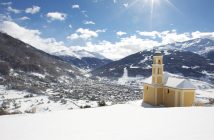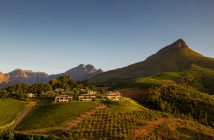In a two-part Bank Holiday special, we venture to that quintessential region in Italy, Tuscany, and discover there are versions of hell that are entirely heavenly. In this first part, Angelina Villa goes subterranean to take the waters (and the wine)…
Hell, it turns out, is not all that bad. Or, rather, Grotta Giusti’s subterranean version of it could be described as such. Hell on earth, you see, can be found in the age-old caves that form the heart of the spa at this unique Tuscan resort.
Part of The Italian Hospitality Collection – one of five charming properties found in Tuscany, Sardinia and Courmayeur – Grotta Giusti Hotel & Spa has what is the most unusual wellness offering you’re ever likely to experience. While above ground, the hotel is a typical historic villa of the kind that romantic novels are based around – you will find original frescos dating back to the 1800s, amber-coloured walls and fragrant gardens – underground lies another world.
Its signature treatment is designed around the most dramatic caves, which are located underneath the hotel, complete with stalactite and stalagmites, caverns and a vast lake. In fact, stretching over 200m below the resort, it is the largest thermal cave in Europe, dating back millions of years.

Here, guests can partake in a sort of mobile sauna session. When you descend into the caves, you’ll find three distinct areas – Heaven, Purgatory and Hell – through which you can meander, experiencing rising temperatures, from 28° to 34°C as well as natural steam. As the heat rises, you eventually arrive at Hell. Here, instead of facing your demons, you will find large vaults in the rock formations, to sit and take in the steam for a therapeutic 20 minutes. Revelatory stuff. To finish the experience off, at the bottom of the cave lies Limbo, a still, crystal-clear pool of water where you can cool down or book in for a number of holistic treatments – such as flotation therapy and scuba diving.
Found in Monsummano Terme, close to Florence and Pisa, Grotta Giusti is a one-of-a-kind sort of place. As well as its surreal world underneath its foundations, surrounding the resort is a wondrous 45-hectare park, which was originally designed by landscape architect Pietro Porcinai at the start of the 20th century. Recently restored to its former glory, it is a fragrant place to wander around – with Cypress trees dotting the hillsides, ancient churches punctuating the views and hiking trails to work off the previous night’s pasta.

Last year, the property had a €1.5m revamp which included a fresh look for the 64 bedrooms. Décor is elegant and restrained with crisp linens on the beds, marble bathrooms and terraces to showcase the garden views. While nothing is too fussy, everything reveals enough levels of luxury for it to feel special. Downstairs in the oldest part of the house, dating back to 1849, are a series of lounges which reveal a sense of faded grandeur. A cosy bar, carved out of an original chapel, is just the place to start the evening off, especially with the award-winning barman’s cocktail menu (a must is the ‘Nobody’s Perfect’ – the most perfect blend of prosecco, vodka, Aperol, pineapple and cranberry).
Grotta Giusti was once home to the 19th-century Tuscan poet, Giuseppe Giusti, who counted the composer Giuseppe Verdi as one of his friends. While original colourful frescos, antique furniture and tapestries give a nod to the past, there are also lime-green Murano glass chandeliers and crimson seating to add modern flashes of colour.

By day, you can spend hours exploring the rest of the spa – it really is the showpiece of the resort. As well as the grotto, there are two outdoor thermal pools, and a huge choice of treatments, including a choice of mud therapies. It also has a comprehensive medical spa with a flagship, seven-day Equilibrium programme, aimed at weight-loss and anti-stress. During the week, guests are given a personalised approach with relaxation techniques, microbiotic-diet plans, physical exercise and spa therapies included.
Refreshingly, you don’t have to commit to this to channel healthy eating. In the main restaurant, La Veranda, chef Guido Lotti showcases his passion for light, healthy and, most importantly, delicious cuisine. This being Italy, there’s ample opportunity to tuck into home-made pastas, of course, but most are on the healthy side, such as the standout ‘Spaghetti with Salt Cod Ragu’.
Exploring the area is a must. Nearby is the medieval town of Lucca, which is worth a day-trip, and a 20-minute drive away, in San Giuliano Terme, a noted spa-town, is Grotta’s sister property – Bagni di Pisa.

This former palazzo is the jewel in the crown of the hotel group and also has a rich history at its heart. Once the summer home of the Grand Duke Francesco di Lorena, it dates back to the 18th century, and is layered with references to its past. Perhaps more famous than its actual owner are the guests he used to attract: Lord Byron and Percy and Mary Shelley among them – now immortalised in various areas of the hotel (the Shelley Lounge and the Byron Court Terrace, for instance).
Interiors are beautifully ornate and sumptuous – especially in the 11 suites. Each of these, will give you a wow moment the second you lay on the bed. That’s right: lie back and think of Italy and, in fact, up above you is a reminder of the country’s rich artistic heritage – with each suite boasting ornate hand-painted frescoes on their vaulted ceilings. Curtains are made of taffeta, beds are draped in thick fabric and layered with soft velvet throws. Carrera marble bathrooms are regal, while separate living rooms are cocooning spaces filled with art books, distressed mirrors and antique chairs.
Head chef Umberto Toscano has also looked to the past for his inspiration in the Dei Lorena Restaurant. As you eat his typical Tuscan dishes – some based on recipes which were served during the Grand Duke’s time but nowadays given a healthy twist – you can spot the Leaning Tower of Pisa in the distance. Fresh pasta dishes include ‘Buckwheat Tagliatelli with Broccoli, Bacon and Olives’ and ‘Gnocci with Seafood Sauce and Courgettes’. There is also an emphasis on fish with a typical hearty fish soup being one of the signature dishes.

The Shelley Lounge is a lavish space for pre-dinner wine tasting, courtesy of sommelier Mirko Michelotti, who keeps his choices local. Underneath a ceiling of painted, flying cherubs, you’ll soon learn the difference between Chianti and Chianti Classico.
The spa is also a main focus here and is built around two original bath houses found in two wings of the hotel – ‘Levante’ and ‘Ponente’ – which date back to the Etruscan period. Just like Grotta Giusti, Bagni di Pisa has its own thermal spring waters, rich in sulphur, calcium and magnesium. Flowing out of the ground at 37°C, they are used in various areas of the spa – such as therapeutic baths, mud baths and thermal pools. Said to be ‘cures’ in their own right, the waters help the respiratory system, skin complaints, and muscles. A highlight is the Hammam dei Granduchi, a small natural cave with a waterfall and stone bath cut into the rock. It’s hellishly delightful.
Nightly rates at Grotta Giusti start from €144 (£125) per person per night in a Comfort Room on a B&B basis. For more information, visit www.grottagiustispa.com.
Nightly rates at Bagni di Pisa start from €150 (£131) per person per night in a Comfort Room on a B&B basis. For more information, visit www.bagnidipisa.com.
Our two-part Tuscany special continues tomorrow when Larry discovers another form of hell, of the ‘angel’ variety…




